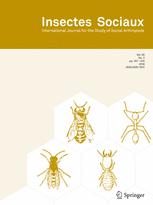View Item
- xmlui.general.dspace_homeCentros Regionales y EEAsCentro Regional Buenos Aires NorteEEA Delta del ParanáArtículos científicosxmlui.ArtifactBrowser.ItemViewer.trail
- DSpace Home
- Centros Regionales y EEAs
- Centro Regional Buenos Aires Norte
- EEA Delta del Paraná
- Artículos científicos
- View Item
Heptyl butyrate, a putative pheromone involved in social communication of Vespula germanica wasps
Abstract
Greater knowledge on the social communication of invasive Vespula germanica wasps is needed to fully understand their foraging behavior. This is particularly valuable considering that poison baiting is currently the only effective way of reducing wasp density. Heptyl butyrate is an attractant for many wasp species, but attempts to determine effects on V. germanica have yielded mixed results. We studied the behavior elicited by heptyl butyrate on V.
[ver mas...]
Greater knowledge on the social communication of invasive Vespula germanica wasps is needed to fully understand their foraging behavior. This is particularly valuable considering that poison baiting is currently the only effective way of reducing wasp density. Heptyl butyrate is an attractant for many wasp species, but attempts to determine effects on V. germanica have yielded mixed results. We studied the behavior elicited by heptyl butyrate on V. germanica wasps in field experiments with foraging wasps. We also analyzed headspace volatiles of live V. germanica workers, to determine if heptyl butyrate is emitted. Heptyl butyrate was present in the headspace of live workers. Amounts of heptyl butyrate averaged 1.4 ± 0.2 ng per sample per hour, where each sample included six workers. Wasps approaching filter papers treated with different concentrations of heptyl butyrate hovered over it, but only a small percentage landed on it. Pure heptyl butyrate elicited the greatest response although all the concentrations tested were attractive. When heptyl butyrate was applied to protein baits, a greater number landed on the treated baits than on untreated ones, demonstrating this compound enhances attractiveness of baits. Results from our study suggest that heptyl butyrate is a pheromonal compound involved in attracting conspecifics to food resources, but other cues are needed to trigger landing.
[Cerrar]

Author
Buteler, Micaela;
Fernandez, Patricia;
Stadler, Teodoro;
Weaver, David K.;
Yossen, Belen;
Lozada, Mariana;
Fuente
Insectes Sociaux 65 (1) : 95–101 (February 2018)
Date
2018-02
ISSN
0020-1812
1420-9098
1420-9098
Formato
pdf
Tipo de documento
artículo
Palabras Claves
Derechos de acceso
Restringido
 Excepto donde se diga explicitamente, este item se publica bajo la siguiente descripción: Creative Commons Attribution-NonCommercial-ShareAlike 2.5 Unported (CC BY-NC-SA 2.5)
Excepto donde se diga explicitamente, este item se publica bajo la siguiente descripción: Creative Commons Attribution-NonCommercial-ShareAlike 2.5 Unported (CC BY-NC-SA 2.5)

